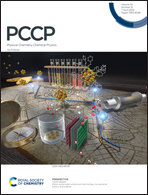Identification of functional substates of KRas during GTP hydrolysis with enhanced sampling simulations†
Abstract
As the hub of major signaling pathways, Ras proteins are implicated in 19% of tumor-caused cancers due to perturbations in their conformational and/or catalytic properties. Despite numerous studies, the functions of the conformational substates for the most important isoform, KRas, remain elusive. In this work, we perform an extensive simulation analysis on the conformational landscape of KRas in its various chemical states during the GTP hydrolysis cycle: the reactant state KRasGTP·Mg2+, the intermediate state KRasGDP·Pi·Mg2+ and the product state KRasGDP·Mg2+. The results from enhanced sampling simulations reveal that State 1 of KRasGTP·Mg2+ has multiple stable substates in solution, one of which might account for interacting with GEFs. State 2 of KRasGTP·Mg2+ features two substates “Tyr32in” and “Tyr32out”, which are poised to interact with effectors and GAPs, respectively. For the intermediate state KRasGDP·Pi·Mg2+, Gln61 and Pi are found to assume a broad set of conformations, which might account for the weak oncogenic effect of Gln61 mutations in KRas in contrast to the situation in HRas and NRas. Finally, the product state KRasGDP·Mg2+ has more than two stable substates in solution, pointing to a conformation-selection mechanism for complexation with GEFs. Based on these results, some specific inhibition strategies for targeting the binding sites of the high-energy substates of KRas during GTP hydrolysis are discussed.

- This article is part of the themed collection: 2022 PCCP HOT Articles


 Please wait while we load your content...
Please wait while we load your content...